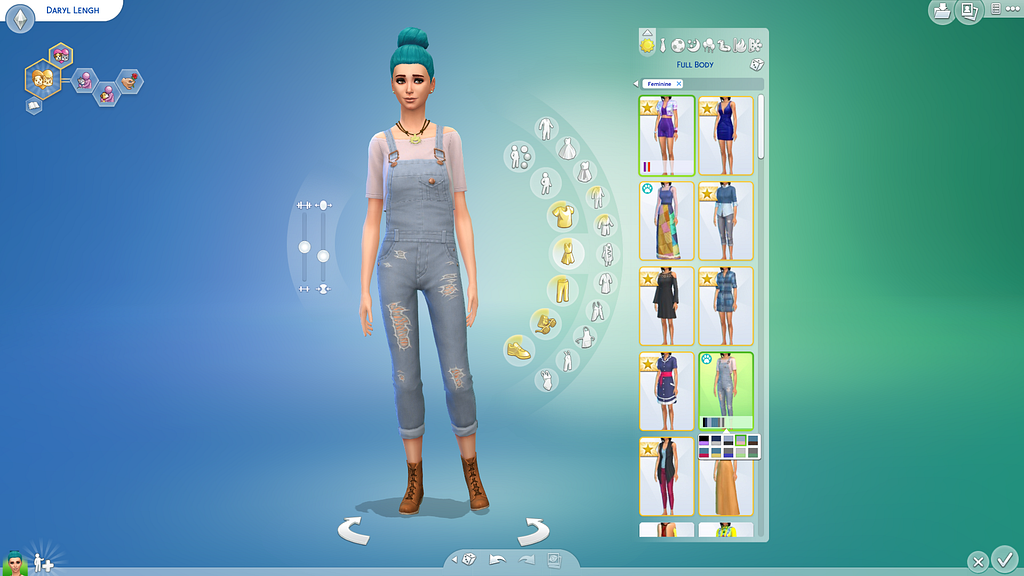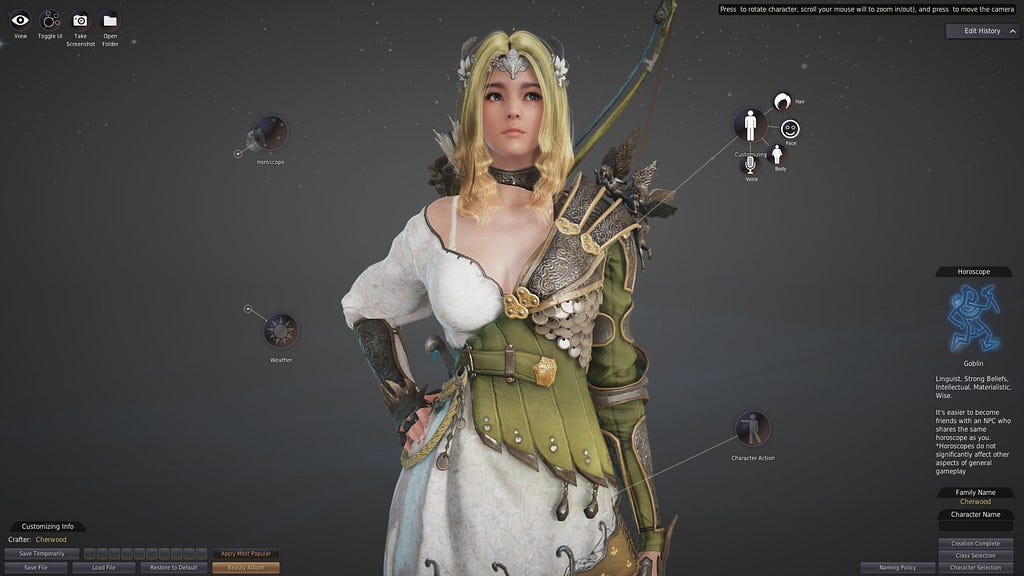A guide to CCIs in game design.

Character creation is an essential aspect of most video games, allowing players to customize their avatars and immerse themselves in the game world. As a user experience (UX) designer, your role in game design is to create an interface that allows players to create unique, engaging characters that fit the game’s narrative. In this post, we’ll explore the research on Character Creation Interfaces (CCIs) and provide insights on how to design effective CCIs.
The Importance of Character Customization in Video Games
Character customization is important in video games because it allows players to create a character that represents them or their desired persona. This increases the level of personal investment in the game, making it more enjoyable and engaging. It also allows players to differentiate themselves from other players, creating a sense of uniqueness and individuality.
Character customization makes a user become more immersed in the story and overall game experience because it allows them to have a personal connection with the character they have created. Players are able to make choices based on their character’s appearance, personality, and abilities, which can affect the outcome of the game. This level of personalization makes the game feel more tailored to the individual player, increasing their emotional investment and overall enjoyment of the experience.
The Impact of Game and Player Mechanics on Character Creation in Video Games
Game mechanics are the rules and systems that govern how a video game operates. They are the building blocks of a game and include things like movement, interaction with the game world, and combat. Game mechanics are designed to create a certain experience for the player and are used to shape the gameplay.
Player mechanics, on the other hand, are the abilities and actions that a player can take within the game. These can include things like character customization, movement, combat, and dialogue choices. Player mechanics are designed to interact with the game mechanics to create a unique gameplay experience for the player.
In terms of character creation, game mechanics and player mechanics play a crucial role in shaping the character. Game mechanics can influence character creation by providing players with options for customization based on the type of game being played. For example, in a role-playing game, game mechanics may allow players to choose from a variety of races and classes, each with their own unique abilities and attributes. In a first-person shooter, game mechanics may allow players to customize their weapons, armor, and other equipment.
Player mechanics also influence character creation by providing players with abilities and actions that can be used to shape the character. For example, in a game with a character creation system, player mechanics may allow players to choose the physical appearance, skills, and personality traits of the character they create. In games with dialogue choices, player mechanics may allow players to shape the character’s personality and relationships with other characters.
The Limited Research on Character Creation
Research on character creation in game design is scarce. However, two studies shed light on how users interact with CCIs. The first study, “The Framework of Player Experience in Game Creation” by Teather et al., explores the player experience in game creation. The second study, “Towards Better Character Creation Interfaces in Games” by Yuhara et al., focuses on improving CCIs.
The Framework of Player Experience in Game Creation
Teather et al. propose a framework for analyzing the player experience in game creation. The research findings are as follows:
- Players enjoy the process of creating a character, but it can be time-consuming and frustrating if the interface is not user-friendly.
- Players tend to focus on aesthetic customization rather than functional customization.
- Players prefer to have a wide range of customization options, but too many options can be overwhelming and lead to decision fatigue.
Towards Better Character Creation Interfaces in Games
Yuhara et al. conducted a study to improve CCIs. The research findings are as follows:
- Players prefer a step-by-step interface that guides them through the character creation process.
- Players value the ability to preview their character in various poses and lighting conditions.
- Players want to be able to save and share their character creations with others.
Designing Effective Character Creation Interfaces
Based on the research findings, here are some tips for designing effective CCIs:
- Keep the interface user-friendly and intuitive. Use a step-by-step approach to guide the player through the character creation process.
- Provide a wide range of customization options, but avoid overwhelming the player with too many choices.
- Allow the player to preview their character in various poses and lighting conditions to enhance the customization experience.
- Include a save and share option to allow players to share their character creations with others, increasing player engagement.
How to design a user-centered character creation interface
Creating a character in a video game is an exciting part of the gaming experience. It allows players to create a character that they can relate to and feel immersed in the game world. However, designing an intuitive character creation interface can be a challenge. Here are 7 steps to design character creation interfaces and the UX in-game user interface design.
Step 1: Understand the Player
Before designing a character creation interface, it is essential to understand the player. Who are they? What kind of characters do they want to create? What are their expectations for the game? Gathering this information will help you create a character creation interface that is tailored to the player’s needs and desires.
Step 2: Keep It Simple
Creating a character creation interface that is simple and easy to use is crucial to a good user experience. Players want to be able to create their characters quickly and easily. A complicated interface can be frustrating and turn players off.
Step 3: Use Visual Cues
Using visual cues can help players understand the character creation interface better. For example, using color to highlight essential areas of the interface or using icons to represent different elements can help players navigate the interface more easily.
Step 4: Provide Contextual Help
Providing contextual help can be helpful in creating an intuitive character creation interface. For example, if a player is unsure what a particular feature does, providing a brief description or tooltip can help them understand its purpose.
Step 5: Show Progress
Showing progress can help players understand where they are in the character-creation process. For example, providing a progress bar or indicator can help players understand how much of the process is left and what steps they have completed.
Step 6: Allow for Experimentation
Allowing players to experiment with different character creation options can be a fun and engaging part of the game. Providing different options and allowing players to preview their character can help them create a character that they are happy with. For example, The Sims 4 allows players to customize their character’s features including hair, outfits, and even non-binary options.
Step 7: Test and Iterate
Testing and iterating on the character creation interface is important to ensure a good user experience. Testing the interface with players and gathering feedback can help identify areas for improvement.
Real-World Examples
Several video games have exceptional character creation interfaces that enhance the overall gaming experience. Here are some real-world examples of great character-creation interfaces:
World of Warcraft

World of Warcraft offers players an expansive range of customization options for their character, including hair and facial features, skin color, and tattoos. The interface is easy to use, and players can see their characters in various poses to get a better idea of how they will look in the game.
The Sims 4

The character creation interface in this game is widely regarded as one of the best in the gaming industry. It offers a wide range of customization options, including facial features, hairstyles, and clothing.
Black Desert Online

This game’s character creation interface is known for its level of detail. It offers a wide range of customization options, including facial features, hairstyles, body shape, and even tattoos.
Elder Scrolls Online

The character creation interface in this game is known for its vast range of customization options. Players can customize their character’s race, gender, facial features, and even skills. It also allows players to create non-binary characters by offering gender-neutral pronouns.
The Importance of Non-Binary Genderless Options
Non-binary genderless options are crucial for inclusivity in character creation interfaces. By offering non-binary and genderless options, game designers can create a more welcoming and inclusive environment for players of all genders.
For many players, character creation is an opportunity to create a representation of themselves in the game world. By offering non-binary and genderless options, game designers can ensure that all players feel seen and heard in the game world. Here are five games that have non-binary character creation interfaces:
- Cyberpunk 2077 — Despite the controversy surrounding the game’s launch, Cyberpunk 2077’s character creation interface is known for its level of detail and customization options. It offers a wide range of body types, hairstyles, and facial features, and allows players to create non-binary characters.
- Monster Hunter: World — This game’s character creation interface is known for its level of detail and customization options. It allows players to create characters of different genders and body types, including non-binary and genderless options.
- Saints Row IV — The character creation interface in this game allows players to create characters of any gender, including non-binary and genderless options. It also offers various customization options, including facial features, hairstyles, and clothing.
- The Elder Scrolls Online — This game’s character creation interface offers various customization options, including gender-neutral options for hairstyles and clothing. It also allows players to create non-binary characters by offering gender-neutral pronouns.
In conclusion, the character creation interface is an integral part of the gaming experience, and designing an intuitive interface is crucial to a good user experience. Understanding the player, keeping it simple, using visual cues, providing contextual help, showing progress, allowing for experimentation, and testing and iterating are all essential aspects of creating a successful character creation interface. By following these user experience best practices and utilizing available resources, UX designers, UI designers, visual designers, and game artists can create an engaging character creation interface that enhances the overall gaming experience.
References
https://medium.com/media/5e9b1212c77cea1de419612c698f43ef/href
- The UX Design Process: Building a Simple Character Creator
- Shadowlands: An Inside Look at the Character Creation UI Redesign
Follow me on Twitter @polliea_ | Let’s connect on Linkedin
Thanks for reading!
Character creation UX was originally published in UX Collective on Medium, where people are continuing the conversation by highlighting and responding to this story.